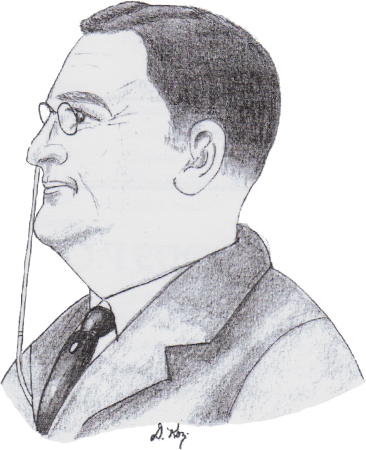theater visionary with strong ties to Milford
Situated behind a stone wall at the intersection of Merwin Avenue and Abigail Street in Woodmont is the estate of the late Sylvester Z. Poli. Long time residents of Milford are familiar with the local landmark. Not too many, on the other hand, may know much about than who resided in the estate fronting Long Island Sound.
Poli, who was referred to by friends and associates simply as "SZ," was a visionary who in the late 19th century saw the potential of live theater and, therefore, legitimatized vaudeville without the bawdiness for which it previously had gained notoriety. He was one of the first entrepreneurs to recognize the potential of the motion picture and he was responsible for helping to launch the careers of such noted stage screen starts as Al Jolson and James Cagney, among others. Poli also amassed a fortune by buying, renovating, restoring or building theaters from New England to Washington, DC. The famed College Theater in downtown New Haven, for example, was wants a Poli property. By the time he died in the spring of 1937 at the age of 80, he was a business mogul whose reputation was matched only by very few others. Is Woodmont estate is a tribute not only to the man and his accomplishments but also to his foresight add to the entertainment industry he helped to flourish.
Sylvester Z Poli was born on the last day of 1858 in Piano Lucca, Tuscany, Di Coreglio, Italy. Because he showed an early talent for sculpting and clay modeling, a well known sculpture invited the 13-year-old to go to France and become the sculpture’s apprentice. Within a short period of time Poli mastered the modeling and sculpting craft and learned how to sculpt in wax. Following 32 months service with the Army, he returned to Paris and his studies where his work was quickly noticed by the museum director who hired him to work in the institution’s historical wax collection. It was while he was at this museum that Poli became skilled in modeling from sketches. As a result, he was offered an opportunity to come to the United States. He sailed to New York in the fall of 1881 and never looked back. It was during his museum career in New York they met his wife to be, Rosa Leverone, who was born in Genoa, Italy. "It was love at first sight," Mrs. Poli confided. They were married three months later. Poli was 27 at the time, his wife was 16. They would become lifetime partners, not only in marriage but in business as well.
In late 1886, Poli what's invite to relocate to Philadelphia to become chief modeler at the new Egyptian Museum. Two days after his new exhibit opened, fire engulfed the building that housed the museum. His exhibit, however, miraculously survived the conflagration. It was relocated and became so successful that Poli took it on tour to other cities. He traveled extensively with similar shows until 1889 decided he had sufficient experience to open his own museum. He and a partner opened Robinson and Company in Toronto, a three-story building that featured a wax museum on the third floor, curios and a menagerie on the second floor and a variety show on first floor.
After two years with Robinson and Company, Poli thought about posting his first Poli Museum and rented an abandoned church in Troy, New York. When he lost his lease two years later he traveled to Springfield, Massachusetts, Hartford and New Haven to explore new business opportunities. New Haven seemed to offer the best chance to succeed so Poli leased the second floor of the building at Church and Crown Streets in downtown New Haven where he opened a museum in 1892 it was so successful that “SZ" leased an additional floor and build a stage for vaudeville shows which eventually did nine performances a day. He decided 12 months later that he needed a more comfortable theater with permanent seats for his "High Class Vaudeville" so Poli moved to an old church on Church Street that had been extensively remodeled. Its owners were so impressed by the young man's confidence and persuasive personality they withdrew their demand for one year’s rent in advance. He and his wife began working on the new project. The wax figures were cleaned, rejuvenated and moved to the new quarters. Poli and his wife decorated their own theater. Out went the bawdy acts that were replaced by clean shows that became the foundation of the Poli entertainment empire. Performances were staged to attract women.
Poli constantly improved and changed his New Haven theater. He added 300 more seats and hired a renowned architect to redesign the complex. These changes made him wealthy; which enabled him to acquire a second theatre, in Waterbury, where he leased a building and created a large stage that attracted touring companies and he staged plays and musicals. He purchased the Park City Theater in Bridgeport at a public auction a few years later to further enhance his number of theaters. His empire further expanded upon the acquisition of the Harford Coliseum in 1903.
Sylvester Poli and Vaudeville grew together as the entrepreneur continued to expand the number of theaters under his control. Al Jolson first appeared at the Poli in New Haven as part of a singing group. Poli suggested that the singer become a single and talk to others in his troupe. Jolson donned blackface and became legendary, thanks to Poli's advice and vision. In order to challenge his competition, Poli opened additional theaters in Boston, Providence, Jersey City and in other cities that were considered to be competitor’s strongholds. He booked asts inexpensively by contracting them between other dates and since the Poli theaters were close to New York, travel time was not a disadvantage.
This same tactic was employed 75 years later by New Haven’s Toad’s Place nightclub to become national known.
Poli befriended the mayor of Wilkes-Barre, Pennsylvania, and in 1906 purchased a building in that town for a theater. He then added a theater in Scranton and foreseeing the growth of motion pictures, moved again to Waterbury where he leased a new 700 seat theater as a motion picture house. He then want on to theater building and buying sprees and acquired a theater in Worchester, Massachusetts, and another one in Washington DC and sought other opportunities to expand his empire. On December 22, 1913, he opened an enormous new Poli Palace in Springfield, Massachusetts, It could seat more than 2000 patrons. It was the first theater designed without supporting columns so that everyone in the house had an unobstructed view of the huge stage. Poli theaters began to dot the northeast and he confided to associate that among his many talents, he adored designing theaters.
When the Italian immigrant and Milford resident felt that Washington, DC needed a new theatre, ”SZ" designed a new one in the nation's capital. He religiously adhered to his long-held philosophy that "If you don't keep up with the trend of the times and let up on your work, someone else will step in and take your place…"
When his son, Edward, who is destined to inherit the family business, died a young age, Poli decided it was time to retire and in 1928 sold his theatres for a sum estimated to be between $16.6 and $25 million. (In 2015 the equivalent value would be $232,496,000 to $350,145,000) "SZ" maintained 76 to 78 percent interest in the properties through first mortgage bonds, however, although retired, Poli encountered financial problems when the stock market crash in 1929 forced the purchaser of his properties into bankruptcy and receivers were appointed to operate the theaters. Poli announced despite these setbacks that "the future of the theater in America will is brighter than ever … I do not come back as a sole owner but will depend upon youth to aid me in the operation of the (Poli) circuit.”
Although 74 years old when he took back control of many of his theaters, Poli advised his staff that one must work to keep young and look young even “if the years were piling up on one."
In 1934, Loew’s theaters acquired the 18 Poli Theaters that "SZ" had owned or controlled. When the Mogul and his wife celebrated their golden anniversary in 1935, President Franklin Roosevelt sent his personal regards and congratulations and 400 guests participated in the event." SZ" and his bride remained a contented couple. Their charity also was well known and he was dubbed a Chevalier of the Crown of Italy by King Victor Emmanuel and Queen Elana while Rosa was bestowed the Italian Cross of Honor. Two years after the gala 50th anniversary event, Poli developed a cold that he could not shake. The entertainment magnate died suddenly of pneumonia at his Villa Rosa estate in Woodmont. Rosa Poli, her husband's teenaged bride died shortly before her 92nd birthday in 1960. Fort daughters, seven grandchildren and 18 grand children survived.



